Factors of Food Preparation Linked to Obesity in New Zealand
VerifiedAdded on 2023/03/17
|7
|2015
|71
Literature Review
AI Summary
This literature review examines the correlation between food preparation factors and obesity, specifically within the context of New Zealand. It explores the rising prevalence of obesity globally and in New Zealand, highlighting the role of Body Mass Index (BMI) in defining obesity. The review focuses on how the increasing consumption of food prepared outside the home, which typically contains higher levels of fats, sodium, and cholesterol and lower levels of fiber and calcium, is linked to rising obesity rates. It contrasts these dietary habits with the benefits of home-cooked meals, which are associated with better nutritional quality and lower risks of weight gain and type 2 diabetes. The review also considers the influence of socioeconomic factors, such as income and access to cooking facilities, on dietary choices and obesity, and examines the inconsistencies in people's health choices. The paper concludes by emphasizing the significant relationship between food preparation methods and obesity fluctuations in New Zealand, underscoring the health implications of dietary choices.
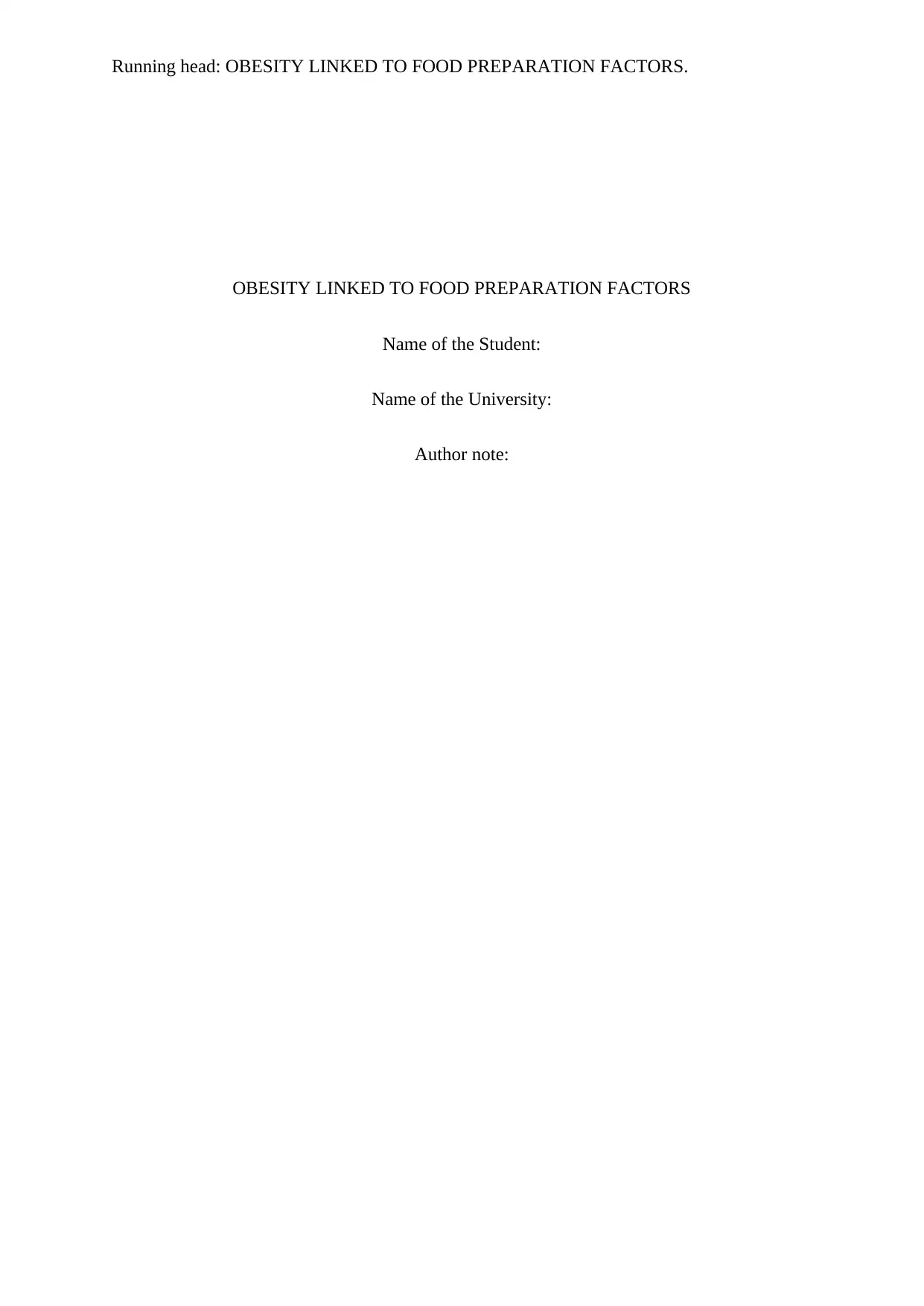
Running head: OBESITY LINKED TO FOOD PREPARATION FACTORS.
OBESITY LINKED TO FOOD PREPARATION FACTORS
Name of the Student:
Name of the University:
Author note:
OBESITY LINKED TO FOOD PREPARATION FACTORS
Name of the Student:
Name of the University:
Author note:
Paraphrase This Document
Need a fresh take? Get an instant paraphrase of this document with our AI Paraphraser
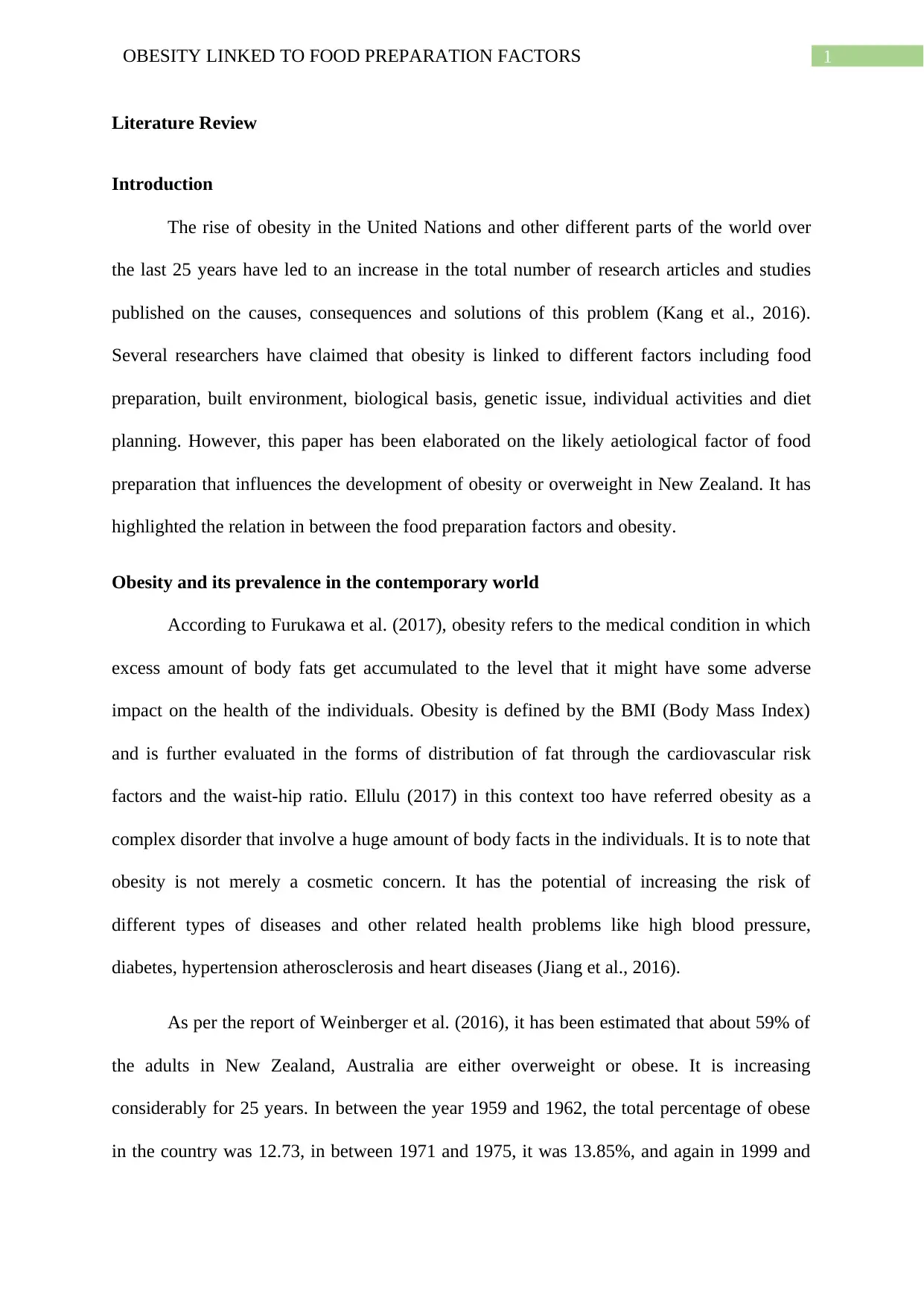
1OBESITY LINKED TO FOOD PREPARATION FACTORS
Literature Review
Introduction
The rise of obesity in the United Nations and other different parts of the world over
the last 25 years have led to an increase in the total number of research articles and studies
published on the causes, consequences and solutions of this problem (Kang et al., 2016).
Several researchers have claimed that obesity is linked to different factors including food
preparation, built environment, biological basis, genetic issue, individual activities and diet
planning. However, this paper has been elaborated on the likely aetiological factor of food
preparation that influences the development of obesity or overweight in New Zealand. It has
highlighted the relation in between the food preparation factors and obesity.
Obesity and its prevalence in the contemporary world
According to Furukawa et al. (2017), obesity refers to the medical condition in which
excess amount of body fats get accumulated to the level that it might have some adverse
impact on the health of the individuals. Obesity is defined by the BMI (Body Mass Index)
and is further evaluated in the forms of distribution of fat through the cardiovascular risk
factors and the waist-hip ratio. Ellulu (2017) in this context too have referred obesity as a
complex disorder that involve a huge amount of body facts in the individuals. It is to note that
obesity is not merely a cosmetic concern. It has the potential of increasing the risk of
different types of diseases and other related health problems like high blood pressure,
diabetes, hypertension atherosclerosis and heart diseases (Jiang et al., 2016).
As per the report of Weinberger et al. (2016), it has been estimated that about 59% of
the adults in New Zealand, Australia are either overweight or obese. It is increasing
considerably for 25 years. In between the year 1959 and 1962, the total percentage of obese
in the country was 12.73, in between 1971 and 1975, it was 13.85%, and again in 1999 and
Literature Review
Introduction
The rise of obesity in the United Nations and other different parts of the world over
the last 25 years have led to an increase in the total number of research articles and studies
published on the causes, consequences and solutions of this problem (Kang et al., 2016).
Several researchers have claimed that obesity is linked to different factors including food
preparation, built environment, biological basis, genetic issue, individual activities and diet
planning. However, this paper has been elaborated on the likely aetiological factor of food
preparation that influences the development of obesity or overweight in New Zealand. It has
highlighted the relation in between the food preparation factors and obesity.
Obesity and its prevalence in the contemporary world
According to Furukawa et al. (2017), obesity refers to the medical condition in which
excess amount of body fats get accumulated to the level that it might have some adverse
impact on the health of the individuals. Obesity is defined by the BMI (Body Mass Index)
and is further evaluated in the forms of distribution of fat through the cardiovascular risk
factors and the waist-hip ratio. Ellulu (2017) in this context too have referred obesity as a
complex disorder that involve a huge amount of body facts in the individuals. It is to note that
obesity is not merely a cosmetic concern. It has the potential of increasing the risk of
different types of diseases and other related health problems like high blood pressure,
diabetes, hypertension atherosclerosis and heart diseases (Jiang et al., 2016).
As per the report of Weinberger et al. (2016), it has been estimated that about 59% of
the adults in New Zealand, Australia are either overweight or obese. It is increasing
considerably for 25 years. In between the year 1959 and 1962, the total percentage of obese
in the country was 12.73, in between 1971 and 1975, it was 13.85%, and again in 1999 and
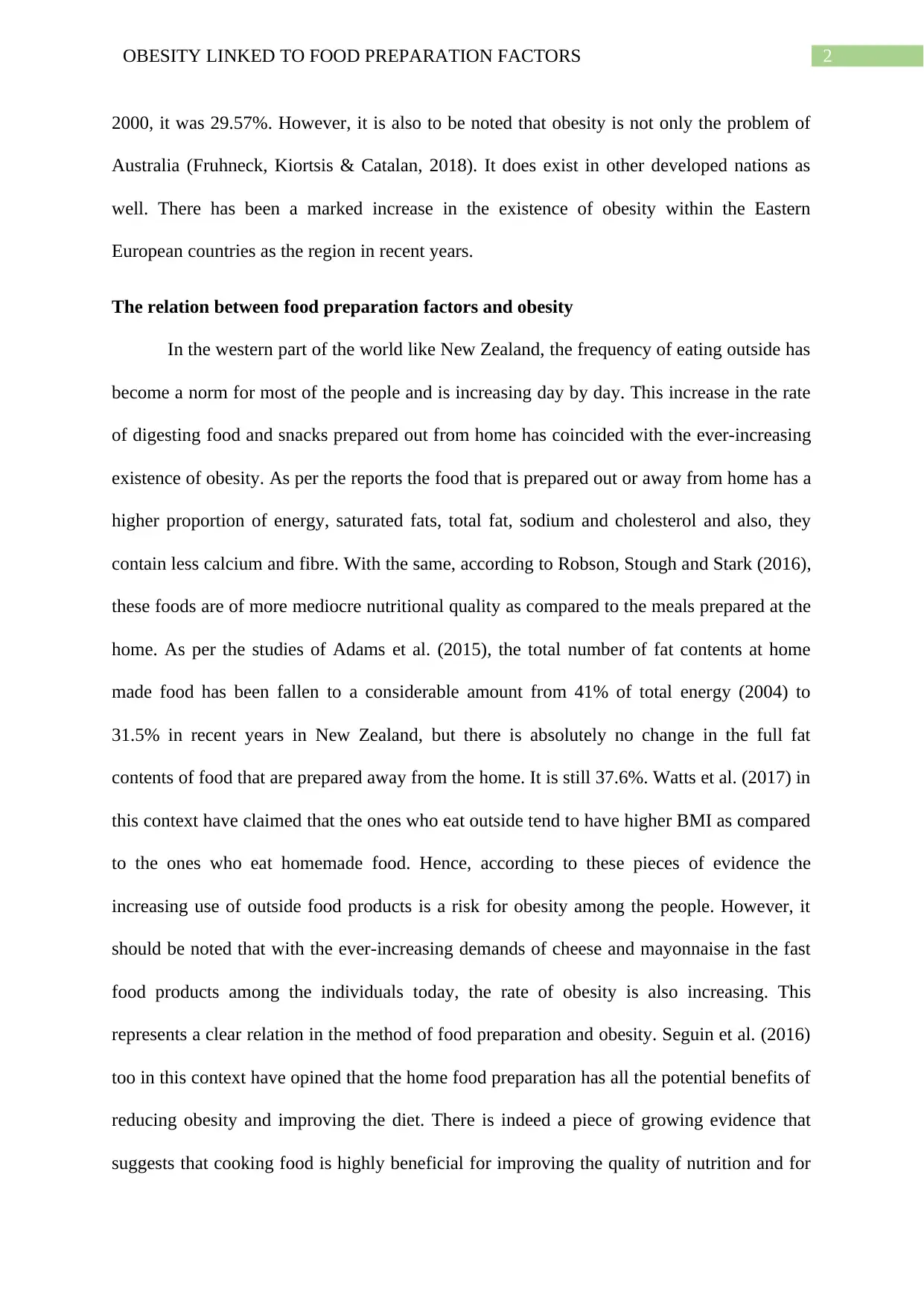
2OBESITY LINKED TO FOOD PREPARATION FACTORS
2000, it was 29.57%. However, it is also to be noted that obesity is not only the problem of
Australia (Fruhneck, Kiortsis & Catalan, 2018). It does exist in other developed nations as
well. There has been a marked increase in the existence of obesity within the Eastern
European countries as the region in recent years.
The relation between food preparation factors and obesity
In the western part of the world like New Zealand, the frequency of eating outside has
become a norm for most of the people and is increasing day by day. This increase in the rate
of digesting food and snacks prepared out from home has coincided with the ever-increasing
existence of obesity. As per the reports the food that is prepared out or away from home has a
higher proportion of energy, saturated fats, total fat, sodium and cholesterol and also, they
contain less calcium and fibre. With the same, according to Robson, Stough and Stark (2016),
these foods are of more mediocre nutritional quality as compared to the meals prepared at the
home. As per the studies of Adams et al. (2015), the total number of fat contents at home
made food has been fallen to a considerable amount from 41% of total energy (2004) to
31.5% in recent years in New Zealand, but there is absolutely no change in the full fat
contents of food that are prepared away from the home. It is still 37.6%. Watts et al. (2017) in
this context have claimed that the ones who eat outside tend to have higher BMI as compared
to the ones who eat homemade food. Hence, according to these pieces of evidence the
increasing use of outside food products is a risk for obesity among the people. However, it
should be noted that with the ever-increasing demands of cheese and mayonnaise in the fast
food products among the individuals today, the rate of obesity is also increasing. This
represents a clear relation in the method of food preparation and obesity. Seguin et al. (2016)
too in this context have opined that the home food preparation has all the potential benefits of
reducing obesity and improving the diet. There is indeed a piece of growing evidence that
suggests that cooking food is highly beneficial for improving the quality of nutrition and for
2000, it was 29.57%. However, it is also to be noted that obesity is not only the problem of
Australia (Fruhneck, Kiortsis & Catalan, 2018). It does exist in other developed nations as
well. There has been a marked increase in the existence of obesity within the Eastern
European countries as the region in recent years.
The relation between food preparation factors and obesity
In the western part of the world like New Zealand, the frequency of eating outside has
become a norm for most of the people and is increasing day by day. This increase in the rate
of digesting food and snacks prepared out from home has coincided with the ever-increasing
existence of obesity. As per the reports the food that is prepared out or away from home has a
higher proportion of energy, saturated fats, total fat, sodium and cholesterol and also, they
contain less calcium and fibre. With the same, according to Robson, Stough and Stark (2016),
these foods are of more mediocre nutritional quality as compared to the meals prepared at the
home. As per the studies of Adams et al. (2015), the total number of fat contents at home
made food has been fallen to a considerable amount from 41% of total energy (2004) to
31.5% in recent years in New Zealand, but there is absolutely no change in the full fat
contents of food that are prepared away from the home. It is still 37.6%. Watts et al. (2017) in
this context have claimed that the ones who eat outside tend to have higher BMI as compared
to the ones who eat homemade food. Hence, according to these pieces of evidence the
increasing use of outside food products is a risk for obesity among the people. However, it
should be noted that with the ever-increasing demands of cheese and mayonnaise in the fast
food products among the individuals today, the rate of obesity is also increasing. This
represents a clear relation in the method of food preparation and obesity. Seguin et al. (2016)
too in this context have opined that the home food preparation has all the potential benefits of
reducing obesity and improving the diet. There is indeed a piece of growing evidence that
suggests that cooking food is highly beneficial for improving the quality of nutrition and for
⊘ This is a preview!⊘
Do you want full access?
Subscribe today to unlock all pages.

Trusted by 1+ million students worldwide
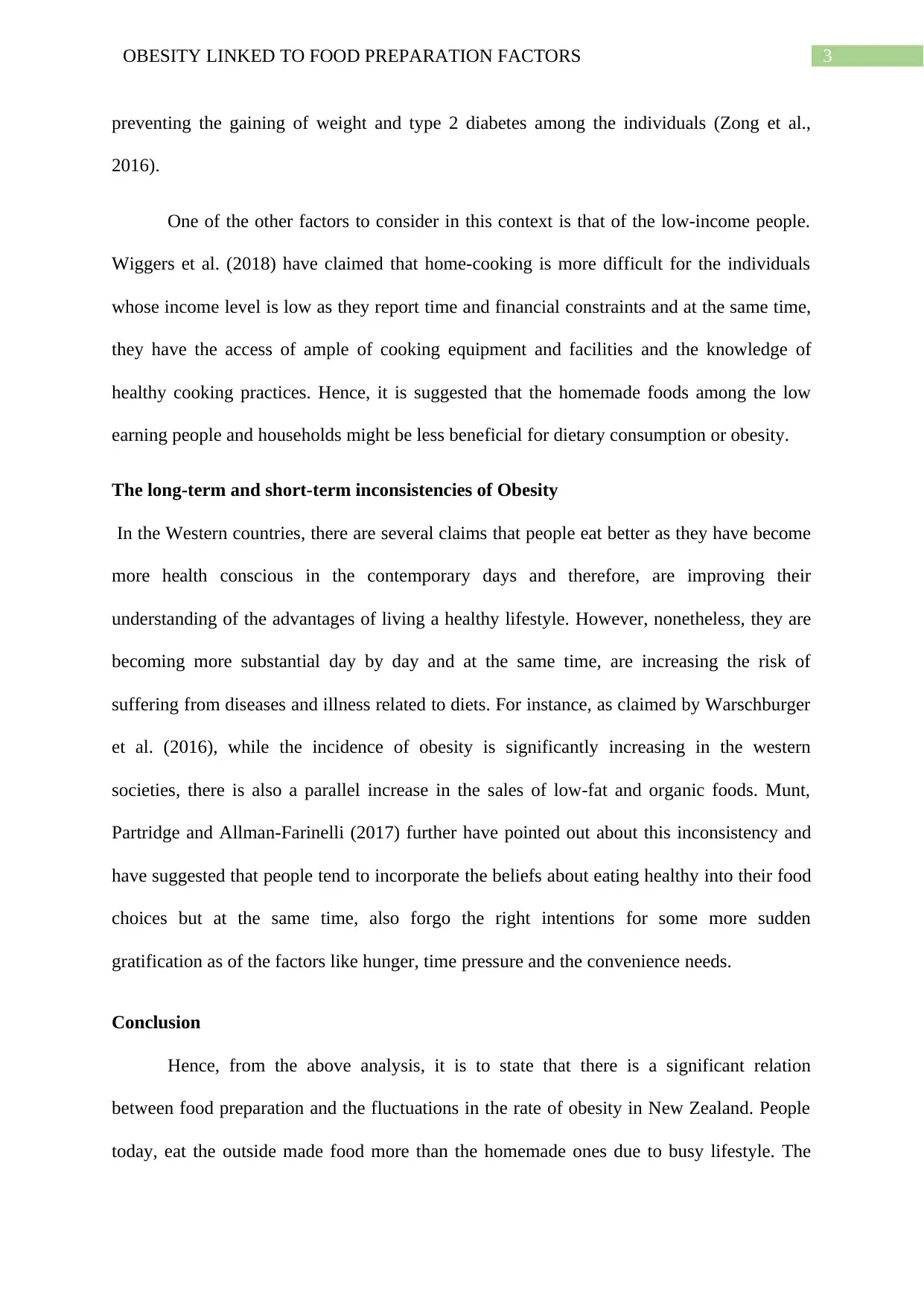
3OBESITY LINKED TO FOOD PREPARATION FACTORS
preventing the gaining of weight and type 2 diabetes among the individuals (Zong et al.,
2016).
One of the other factors to consider in this context is that of the low-income people.
Wiggers et al. (2018) have claimed that home-cooking is more difficult for the individuals
whose income level is low as they report time and financial constraints and at the same time,
they have the access of ample of cooking equipment and facilities and the knowledge of
healthy cooking practices. Hence, it is suggested that the homemade foods among the low
earning people and households might be less beneficial for dietary consumption or obesity.
The long-term and short-term inconsistencies of Obesity
In the Western countries, there are several claims that people eat better as they have become
more health conscious in the contemporary days and therefore, are improving their
understanding of the advantages of living a healthy lifestyle. However, nonetheless, they are
becoming more substantial day by day and at the same time, are increasing the risk of
suffering from diseases and illness related to diets. For instance, as claimed by Warschburger
et al. (2016), while the incidence of obesity is significantly increasing in the western
societies, there is also a parallel increase in the sales of low-fat and organic foods. Munt,
Partridge and Allman-Farinelli (2017) further have pointed out about this inconsistency and
have suggested that people tend to incorporate the beliefs about eating healthy into their food
choices but at the same time, also forgo the right intentions for some more sudden
gratification as of the factors like hunger, time pressure and the convenience needs.
Conclusion
Hence, from the above analysis, it is to state that there is a significant relation
between food preparation and the fluctuations in the rate of obesity in New Zealand. People
today, eat the outside made food more than the homemade ones due to busy lifestyle. The
preventing the gaining of weight and type 2 diabetes among the individuals (Zong et al.,
2016).
One of the other factors to consider in this context is that of the low-income people.
Wiggers et al. (2018) have claimed that home-cooking is more difficult for the individuals
whose income level is low as they report time and financial constraints and at the same time,
they have the access of ample of cooking equipment and facilities and the knowledge of
healthy cooking practices. Hence, it is suggested that the homemade foods among the low
earning people and households might be less beneficial for dietary consumption or obesity.
The long-term and short-term inconsistencies of Obesity
In the Western countries, there are several claims that people eat better as they have become
more health conscious in the contemporary days and therefore, are improving their
understanding of the advantages of living a healthy lifestyle. However, nonetheless, they are
becoming more substantial day by day and at the same time, are increasing the risk of
suffering from diseases and illness related to diets. For instance, as claimed by Warschburger
et al. (2016), while the incidence of obesity is significantly increasing in the western
societies, there is also a parallel increase in the sales of low-fat and organic foods. Munt,
Partridge and Allman-Farinelli (2017) further have pointed out about this inconsistency and
have suggested that people tend to incorporate the beliefs about eating healthy into their food
choices but at the same time, also forgo the right intentions for some more sudden
gratification as of the factors like hunger, time pressure and the convenience needs.
Conclusion
Hence, from the above analysis, it is to state that there is a significant relation
between food preparation and the fluctuations in the rate of obesity in New Zealand. People
today, eat the outside made food more than the homemade ones due to busy lifestyle. The
Paraphrase This Document
Need a fresh take? Get an instant paraphrase of this document with our AI Paraphraser
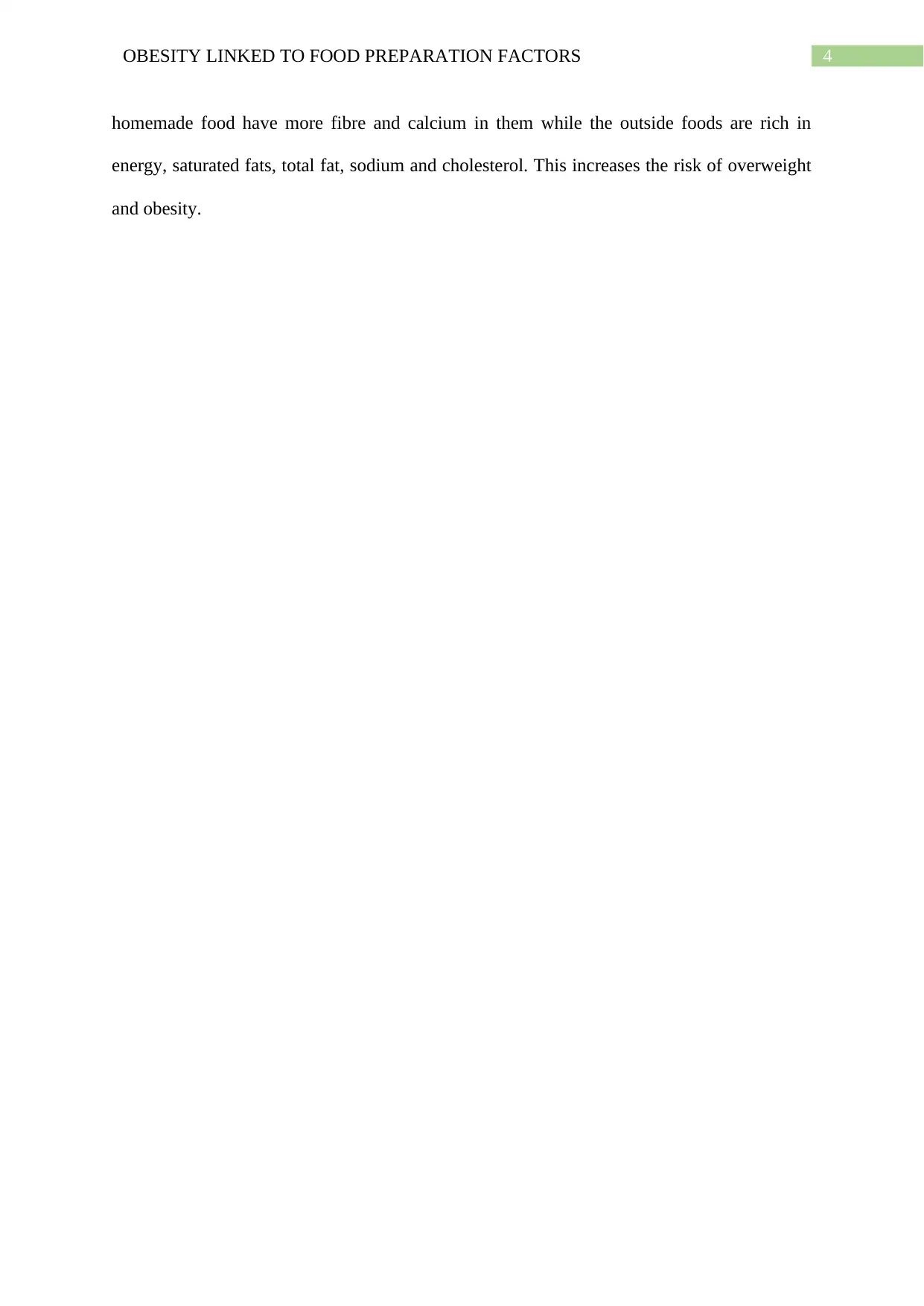
4OBESITY LINKED TO FOOD PREPARATION FACTORS
homemade food have more fibre and calcium in them while the outside foods are rich in
energy, saturated fats, total fat, sodium and cholesterol. This increases the risk of overweight
and obesity.
homemade food have more fibre and calcium in them while the outside foods are rich in
energy, saturated fats, total fat, sodium and cholesterol. This increases the risk of overweight
and obesity.
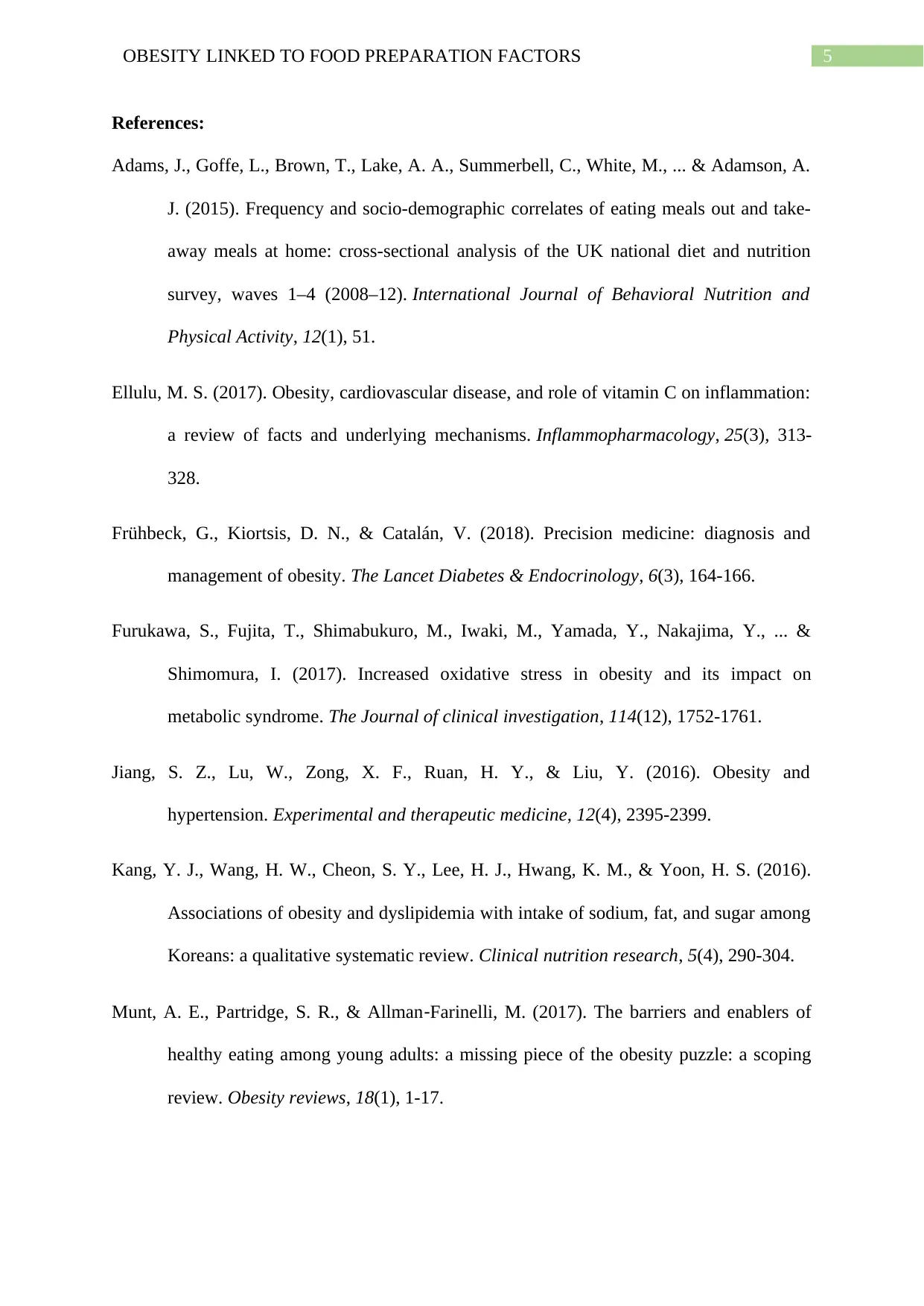
5OBESITY LINKED TO FOOD PREPARATION FACTORS
References:
Adams, J., Goffe, L., Brown, T., Lake, A. A., Summerbell, C., White, M., ... & Adamson, A.
J. (2015). Frequency and socio-demographic correlates of eating meals out and take-
away meals at home: cross-sectional analysis of the UK national diet and nutrition
survey, waves 1–4 (2008–12). International Journal of Behavioral Nutrition and
Physical Activity, 12(1), 51.
Ellulu, M. S. (2017). Obesity, cardiovascular disease, and role of vitamin C on inflammation:
a review of facts and underlying mechanisms. Inflammopharmacology, 25(3), 313-
328.
Frühbeck, G., Kiortsis, D. N., & Catalán, V. (2018). Precision medicine: diagnosis and
management of obesity. The Lancet Diabetes & Endocrinology, 6(3), 164-166.
Furukawa, S., Fujita, T., Shimabukuro, M., Iwaki, M., Yamada, Y., Nakajima, Y., ... &
Shimomura, I. (2017). Increased oxidative stress in obesity and its impact on
metabolic syndrome. The Journal of clinical investigation, 114(12), 1752-1761.
Jiang, S. Z., Lu, W., Zong, X. F., Ruan, H. Y., & Liu, Y. (2016). Obesity and
hypertension. Experimental and therapeutic medicine, 12(4), 2395-2399.
Kang, Y. J., Wang, H. W., Cheon, S. Y., Lee, H. J., Hwang, K. M., & Yoon, H. S. (2016).
Associations of obesity and dyslipidemia with intake of sodium, fat, and sugar among
Koreans: a qualitative systematic review. Clinical nutrition research, 5(4), 290-304.
Munt, A. E., Partridge, S. R., & Allman‐Farinelli, M. (2017). The barriers and enablers of
healthy eating among young adults: a missing piece of the obesity puzzle: a scoping
review. Obesity reviews, 18(1), 1-17.
References:
Adams, J., Goffe, L., Brown, T., Lake, A. A., Summerbell, C., White, M., ... & Adamson, A.
J. (2015). Frequency and socio-demographic correlates of eating meals out and take-
away meals at home: cross-sectional analysis of the UK national diet and nutrition
survey, waves 1–4 (2008–12). International Journal of Behavioral Nutrition and
Physical Activity, 12(1), 51.
Ellulu, M. S. (2017). Obesity, cardiovascular disease, and role of vitamin C on inflammation:
a review of facts and underlying mechanisms. Inflammopharmacology, 25(3), 313-
328.
Frühbeck, G., Kiortsis, D. N., & Catalán, V. (2018). Precision medicine: diagnosis and
management of obesity. The Lancet Diabetes & Endocrinology, 6(3), 164-166.
Furukawa, S., Fujita, T., Shimabukuro, M., Iwaki, M., Yamada, Y., Nakajima, Y., ... &
Shimomura, I. (2017). Increased oxidative stress in obesity and its impact on
metabolic syndrome. The Journal of clinical investigation, 114(12), 1752-1761.
Jiang, S. Z., Lu, W., Zong, X. F., Ruan, H. Y., & Liu, Y. (2016). Obesity and
hypertension. Experimental and therapeutic medicine, 12(4), 2395-2399.
Kang, Y. J., Wang, H. W., Cheon, S. Y., Lee, H. J., Hwang, K. M., & Yoon, H. S. (2016).
Associations of obesity and dyslipidemia with intake of sodium, fat, and sugar among
Koreans: a qualitative systematic review. Clinical nutrition research, 5(4), 290-304.
Munt, A. E., Partridge, S. R., & Allman‐Farinelli, M. (2017). The barriers and enablers of
healthy eating among young adults: a missing piece of the obesity puzzle: a scoping
review. Obesity reviews, 18(1), 1-17.
⊘ This is a preview!⊘
Do you want full access?
Subscribe today to unlock all pages.

Trusted by 1+ million students worldwide
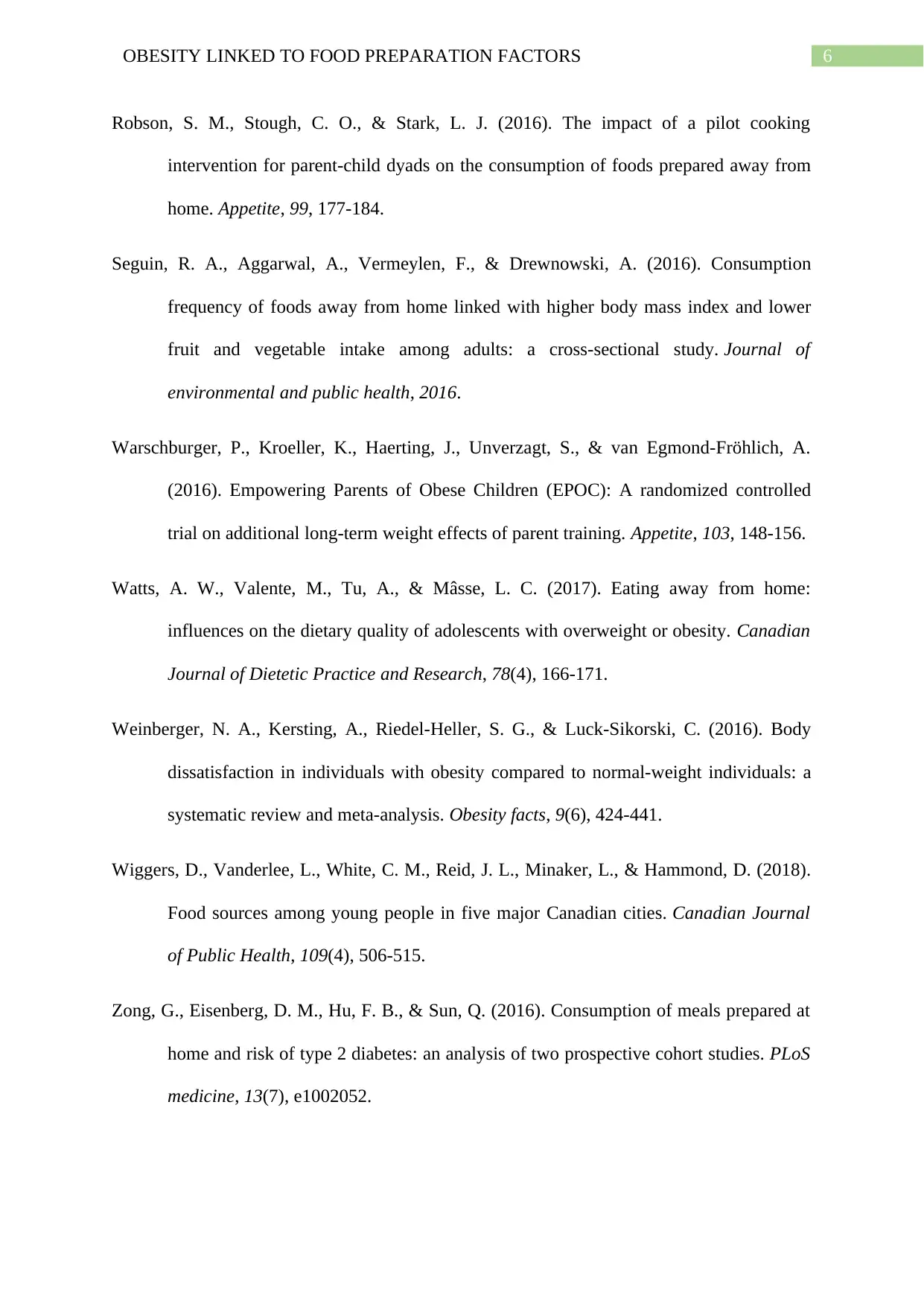
6OBESITY LINKED TO FOOD PREPARATION FACTORS
Robson, S. M., Stough, C. O., & Stark, L. J. (2016). The impact of a pilot cooking
intervention for parent-child dyads on the consumption of foods prepared away from
home. Appetite, 99, 177-184.
Seguin, R. A., Aggarwal, A., Vermeylen, F., & Drewnowski, A. (2016). Consumption
frequency of foods away from home linked with higher body mass index and lower
fruit and vegetable intake among adults: a cross-sectional study. Journal of
environmental and public health, 2016.
Warschburger, P., Kroeller, K., Haerting, J., Unverzagt, S., & van Egmond-Fröhlich, A.
(2016). Empowering Parents of Obese Children (EPOC): A randomized controlled
trial on additional long-term weight effects of parent training. Appetite, 103, 148-156.
Watts, A. W., Valente, M., Tu, A., & Mâsse, L. C. (2017). Eating away from home:
influences on the dietary quality of adolescents with overweight or obesity. Canadian
Journal of Dietetic Practice and Research, 78(4), 166-171.
Weinberger, N. A., Kersting, A., Riedel-Heller, S. G., & Luck-Sikorski, C. (2016). Body
dissatisfaction in individuals with obesity compared to normal-weight individuals: a
systematic review and meta-analysis. Obesity facts, 9(6), 424-441.
Wiggers, D., Vanderlee, L., White, C. M., Reid, J. L., Minaker, L., & Hammond, D. (2018).
Food sources among young people in five major Canadian cities. Canadian Journal
of Public Health, 109(4), 506-515.
Zong, G., Eisenberg, D. M., Hu, F. B., & Sun, Q. (2016). Consumption of meals prepared at
home and risk of type 2 diabetes: an analysis of two prospective cohort studies. PLoS
medicine, 13(7), e1002052.
Robson, S. M., Stough, C. O., & Stark, L. J. (2016). The impact of a pilot cooking
intervention for parent-child dyads on the consumption of foods prepared away from
home. Appetite, 99, 177-184.
Seguin, R. A., Aggarwal, A., Vermeylen, F., & Drewnowski, A. (2016). Consumption
frequency of foods away from home linked with higher body mass index and lower
fruit and vegetable intake among adults: a cross-sectional study. Journal of
environmental and public health, 2016.
Warschburger, P., Kroeller, K., Haerting, J., Unverzagt, S., & van Egmond-Fröhlich, A.
(2016). Empowering Parents of Obese Children (EPOC): A randomized controlled
trial on additional long-term weight effects of parent training. Appetite, 103, 148-156.
Watts, A. W., Valente, M., Tu, A., & Mâsse, L. C. (2017). Eating away from home:
influences on the dietary quality of adolescents with overweight or obesity. Canadian
Journal of Dietetic Practice and Research, 78(4), 166-171.
Weinberger, N. A., Kersting, A., Riedel-Heller, S. G., & Luck-Sikorski, C. (2016). Body
dissatisfaction in individuals with obesity compared to normal-weight individuals: a
systematic review and meta-analysis. Obesity facts, 9(6), 424-441.
Wiggers, D., Vanderlee, L., White, C. M., Reid, J. L., Minaker, L., & Hammond, D. (2018).
Food sources among young people in five major Canadian cities. Canadian Journal
of Public Health, 109(4), 506-515.
Zong, G., Eisenberg, D. M., Hu, F. B., & Sun, Q. (2016). Consumption of meals prepared at
home and risk of type 2 diabetes: an analysis of two prospective cohort studies. PLoS
medicine, 13(7), e1002052.
1 out of 7
Related Documents
Your All-in-One AI-Powered Toolkit for Academic Success.
+13062052269
info@desklib.com
Available 24*7 on WhatsApp / Email
![[object Object]](/_next/static/media/star-bottom.7253800d.svg)
Unlock your academic potential
Copyright © 2020–2025 A2Z Services. All Rights Reserved. Developed and managed by ZUCOL.




